Samsung Announces Galaxy Tab S7 & S7+: S865+ & 120Hz Tablets
by Andrei Frumusanu on August 5, 2020 2:00 PM EST- Posted in
- Mobile
- Samsung
- Tablets
- Galaxy Tab S7
- Galaxy Tab S7+
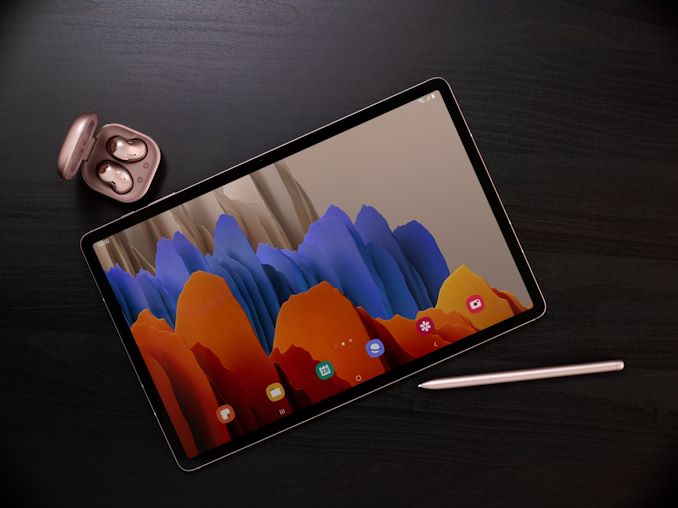
Today alongside the Note20 series smartphones, Samsung is also releasing a pair of new high-end tablets in the form of the new Tab S7 and Tab S7+. It’s been a long time since we’ve seen some good Android tablets as the market is seemingly small and struggling versus the more common-place Appls iPads – but today’s S7 series is really raising the bar in terms of hardware capabilities, bringing some significant updates to the table for what probably are the best Android tablets on the market right now.
What makes the new Galaxy Tab S7 tablets shine is their brand-new Snapdragon 865+ processors alongside high-resolution 120Hz screens, big batteries, quad-speaker setups and a new design that it’s incredibly thin.
| Samsung Tab S7 Series | |||
| Galaxy Tab S7 | Galaxy Tab S7+ | ||
| SoC | Qualcomm Snapdragon 865+ 1x Cortex-A77 @ 3.1GHz 3x Cortex-A77 @ 2.42GHz 4x Cortex-A55 @ 1.80GHz Adreno 640 @ ?MHz |
||
| Display | 11-inch LTPS LCD 2560 x 1600 (16:10) 120Hz |
12.4-inch OLED 2800 x 1752 (16:10) 120Hz |
|
| Dimensions | 253.8 x 163.3 x 6.3mm 498-502g |
285.0 x 185.0 x 5.7mm 575g |
|
| RAM | 6 / 8 GB LPDDR5 | ||
| NAND Storage |
128 / 256GB + microSD |
||
| Battery | 8000mAh (30.96Wh) typ. | 10090mAh (39.04Wh) typ. | |
| 45 Super-fast Charging (18W included charger) |
|||
| Front Camera | 8MP | ||
| Primary Rear Camera | 13MP wide-angle | ||
| Secondary Rear Camera |
5MP ultra-wide-angle | ||
| 4G / 5G Modem |
|||
| Snapdragon 5G - Snapdragon Modem X55 (Discrete) (LTE Category 24/22) DL = 2500 Mbps - 7x20MHz CA, 1024-QAM UL = 316 Mbps 3x20MHz CA, 256-QAM (5G NR Sub-6 + mmWave*) DL = 7000 Mbps UL = 3000 Mbps *Depending on region and model |
|||
| SIM Size | NanoSIM + eSIM | ||
| Wireless | 802.11a/b/g/n/ac/ax 2x2 MU-MIMO, BT 5.0 LE, NFC, GPS/Glonass/Galileo/BDS |
||
| Connectivity | USB Type-C no 3.5mm headset |
||
| Special Features | Side capacitive fingerprint sensor | Under-screen fingerprint sensor | |
| Quad-Speakers with Dolby Atmos | |||
| Launch OS | Android 10 with Samsung OneUI 2.0 | ||
| Launch Prices | 6+128GB (Wi-Fi): $ n/a / 699€ / £619 8+256GB: (Wi-Fi): $ n/a / 779€ / £ n/a 6+128GB (LTE): $ n/a / 799€ / £719 8+256GB: (LTE): $ n/a / 879€ / £ n/a |
6+128GB (Wi-Fi): $ n/a / 899€ / £799 8+256GB: (Wi-Fi): $ n/a / 979€ / £ n/a 6+128GB (5G): $ n/a / 1099€ / £999 8+256GB: (5G): $ n/a / 1179€ / £ n/a |
|
Starting off with the SoC, it features the new high-performance binned Snapdragon 865+ SoC from Qualcomm, with Samsung here using the full 3.1GHz peak frequency on the prime CPU core. It’s a nice performance boost and should make the new Tab S7’s the fastest Android tablets on the market right now.
Samsung is configuring both the Tab S7 and Tab S7+ with either 6GB of LPDDR5 with 128GB of storage, or 8GB of RAM with 256GB. There is a microSD slot for expandable storage.
The star of the show today is the Tab S7+ which features a 12.4” OLED display with a 2800 x 1752 resolution as well as a 120Hz refresh rate that’s enables at the full native resolution of the panel. In essence this checkmarks all the possible features a display can have and should be by far the best tablet experience in the market in this regard.
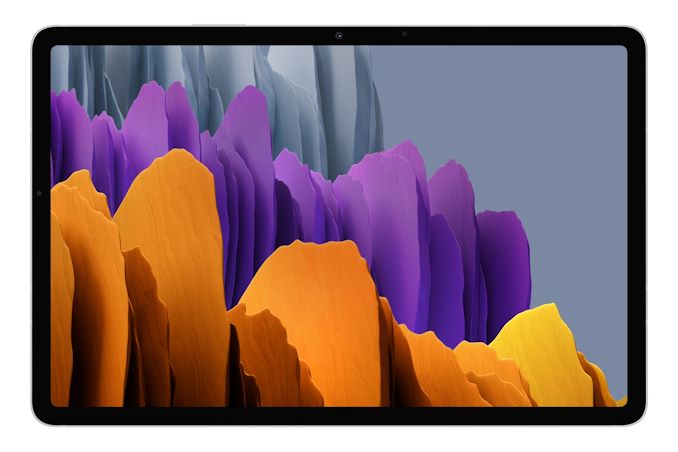 The regular Tab S7 features a similar resolution screen at 2560 x 1600, but at a smaller 11” form-factor and this time around it’s an LCD display. It maintains a 120Hz refresh rate so that will still allow it an extremely smooth content experience.
The regular Tab S7 features a similar resolution screen at 2560 x 1600, but at a smaller 11” form-factor and this time around it’s an LCD display. It maintains a 120Hz refresh rate so that will still allow it an extremely smooth content experience.
The backs of the new tablets are relatively ordinary, except for a prolonged design element that extends from the cameras. This is the charging surface for the new S-Pen which can be held by the accessory Book Cover or Book Cover Keyboard in this position.
The cameras of the tablets are quite nondescript, with Samsung only revealing 8MP for the front camera, a 13MP main camera, and a 5MP ultra-wide angle. We’re not expecting any great quality out of either of these.
Size-wise, as the Tab S7+ is a bigger device, it also has a bigger footprint and weight, about 12% larger in each dimension and a little heavier at 575g. The S7+ features a 10090mAh battery while the S7 features a 8000mAh unit.
Besides the high-quality displays of the new tablets, the one other design element of the new devices is their thickness which comes in at only 6.3mm for the Tab S7 and a mere 5.7mm for the Tab S7+, making the latter the thinnest tablet of this class ever made.
Alongside the side frames we find four speaker grills which house the quad-speaker setup of the tablets, with audio being tuned by AKG and also supporting Dolby Atmos.
The Tab S7 and S7+ will come in either Wi-Fi, LTE (S7 only) and 5G variants (market dependent). Availability of the different models with different configurations as well as RAM and NAND capacity will be highly dependent on local region. In mainland Europe, the Tab S7 starts at 699€ for the Wi-Fi model, and 799€ for the LTE model. The Tab S7+ starts at 899€ for the Wi-Fi variant, and 1099€ for the 5G variant. An upgrade to the 8+256GB variants costs an extra 79€ on top of that.
Availability starts August 24th.


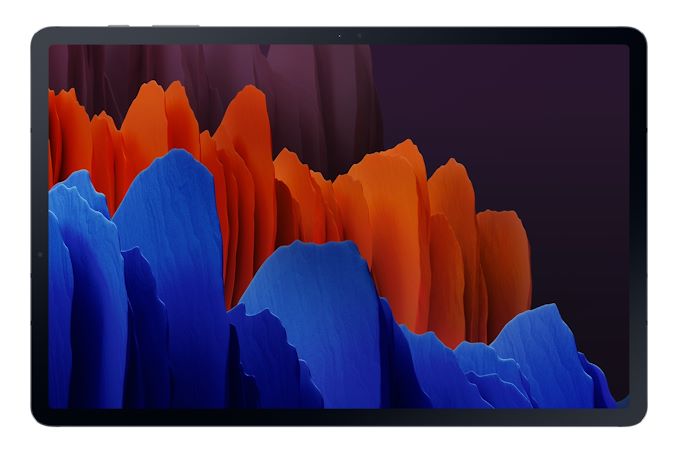
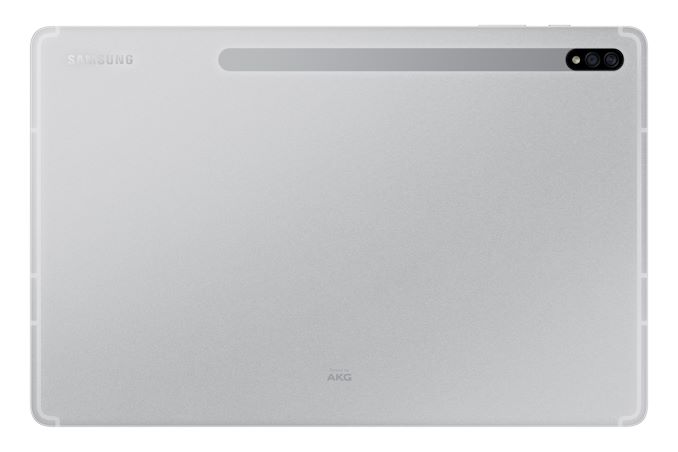
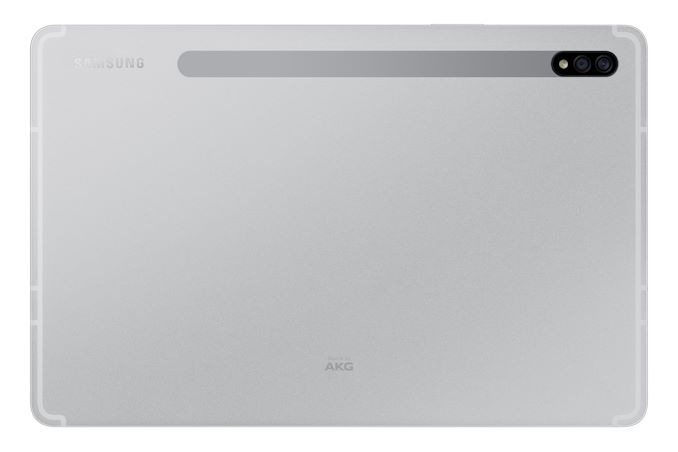










74 Comments
View All Comments
danbob999 - Wednesday, August 5, 2020 - link
Even the typical power user doesn't need 120Hz. This tablet is not meant to be a special tool for specific gaming cases. It's a high end general purpose tablet, an iPad competitor.The very same people using this tablet are going to use a 60 Hz refresh rate on their computer. I am typing this on a 30 Hz refresh rate (my HDMI output is limited to 4k @ 30 Hz). It's a bit low but good enough for web browsing and typical job work (coding/email/office/whatever)
Spunjji - Thursday, August 6, 2020 - link
It has a stylus - the implied use case is for somebody who uses that, and having a high refresh rate dramatically improves the apparent responsiveness of the inking process. Apple already proved this out pretty successfully with the iPad Pro.Try inking at 30Hz, see where that gets you. The change from 60Hz to 120Hz doesn't feel quite so dramatic on the way up, but it sure feels that way on the way back down.
dotjaz - Wednesday, August 5, 2020 - link
You are so dumb, most people don't have smartphones 10 years ago, how about you stop using one? It's a gimmick.brucethemoose - Thursday, August 6, 2020 - link
Smoothness and responsiveness.I have a 120hz phone, and I havent touched a mobile game in years, but I can never go back to 60 now. It feels like night and day.
brucethemoose - Thursday, August 6, 2020 - link
*Also, with an appropriate video player, theres less jitter at 120 than at 60. Its pretty dramatic in slow pans.Lolimaster - Thursday, August 6, 2020 - link
60hz is not a multiple of 24fps like you have on bd rips or anime.Meanwhile 120hz perfectly scales with 24-30-60fps content.
mrvco - Thursday, August 6, 2020 - link
If for no other reason to win the spec sheet wars. Regardless, 90Hz / 120Hz is the nu hawt for phones, so why not for tablets?Spunjji - Thursday, August 6, 2020 - link
For the typical tablet user, there's the typical 60Hz tablet.For someone who regularly uses a pen and/or wants a more "premium" experience, there are now 120Hz tablets. 👍
PeachNCream - Wednesday, August 5, 2020 - link
Seems a lot less functionally flexible than a cheap Windows tablet for a much higher price with only a few fairly unimportant marketing bullet points (like screen refresh rate) to make a vague attempt at justification of the high cost. I guess there's the argument that Apple also will charge buyers quite a high cost for an iPad, so there is that, but really.Meaker10 - Wednesday, August 5, 2020 - link
Much longer battery life on this compared to a Windows device. The display will be better in general too and it will be lighter.